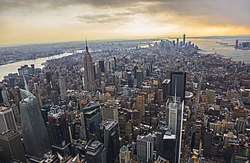A global city (also known as a power city, world city, alpha city, or world center) is a city that serves as a primary node in the global economic network. The concept originates from geography and urban studies, based on the thesis that globalization has created a hierarchy of strategic geographic locations with varying degrees of influence over finance, trade, and culture worldwide. [1] [2] [3] The global city represents the most complex and significant hub within the international system, characterized by links binding it to other cities that have direct, tangible effects on global socioeconomic affairs. [4]
Contents
- Origin and terminology
- Criteria
- Rankings
- GaWC World Cities
- Global Cities Index (Kearney)
- Global Cities Index (Oxford Economics)
- Global Power City Index
- World's Best Cities ranking
- Global Financial Centres Index
- See also
- References
The criteria of a global city vary depending on the source. [5] Common features include a high degree of urban development, a large population, the presence of major multinational companies, a significant and globalized financial sector, a well-developed and internationally linked transportation infrastructure, local or national economic dominance, high quality educational and research institutions, and a globally influential output of ideas, innovations, or cultural products. Global city rankings are numerous. [6] New York City, London, Tokyo, and Paris are the most commonly mentioned. [7] [8]


